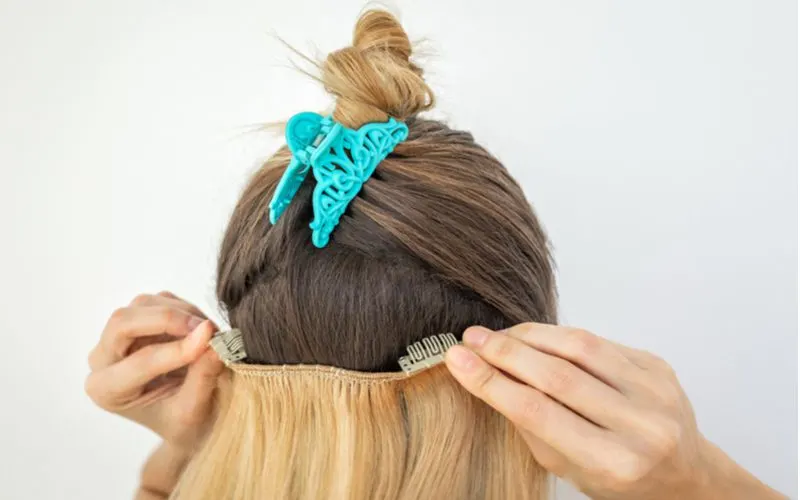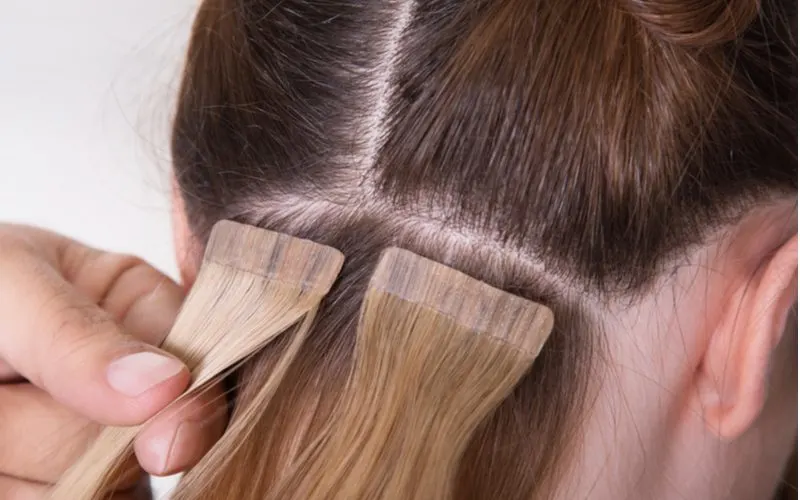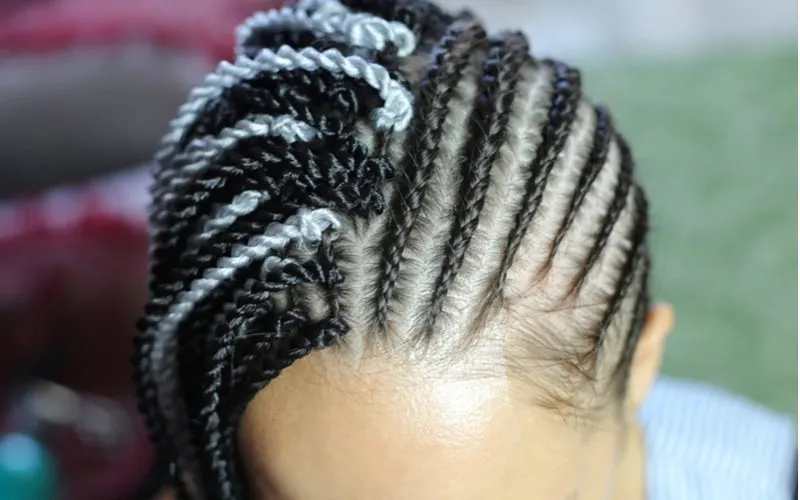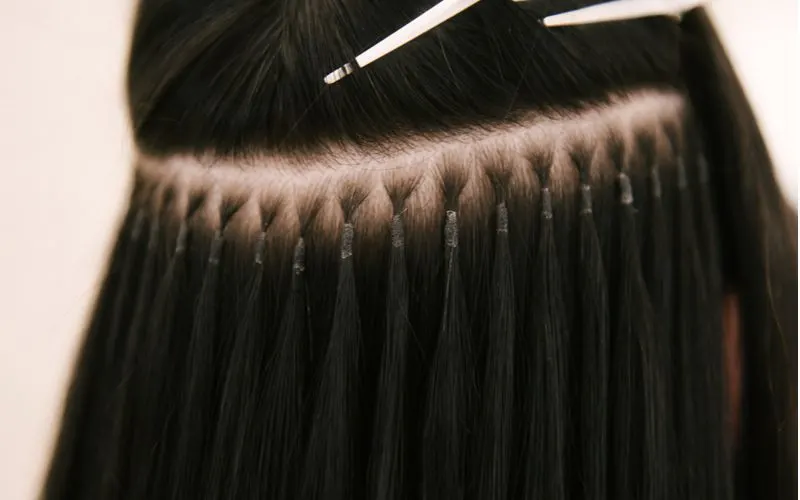Jump to:
You might be looking into adding some extra length and volume to your hair or even wanting to try a brand-new look with hair extensions. Let’s take a look at the different hair extensions available and how long they last. It’s not as long as you think.
How Long Do Hair Extensions Last?

Hair extensions come in a variety of textures, lengths, colors, and qualities. Just as there are many types of extensions to choose from, there are many ways you can get your extensions to stay in your hair (application techniques, if you will). While the different extension types and application techniques can all be used for the same purpose — to give you more hair– each needs to be cared for a bit differently. And each type needs to be adjusted regularly. Here’s how often:
- Clip-Ins. Clip-ins can stay in for a few days, but it’s recommended to remove and adjust them daily.
- Tape. Tape extensions can last for up to 8-10 weeks with proper application and care.
- Sewn/Weave. When applied properly, sewn/weave extensions generally last for 8-10 weeks.
- Micro-Links. Like the previous extension, micro-links can last for 8-10 weeks before needing adjustment.
- Keratin. Keratin extensions last up to 6 months if applied by a professional. The average wear time is 8-12 weeks before they need adjustment.
What Are Hair Extensions?

Leszek Glasner/Shutterstock
You are probably familiar with how hair extensions work. They can add length, volume, and a vibrant pop of color to your hair, and there are various ways to apply them to your head. There’s an extension of every length and hair type.
Hair extensions are attached to existing hair through bonds, tape, or weaves. Temporary clip-in extensions are also an option and can be done at home with some practice. The other methods should be attached and blended into your natural hair by a trained professional for the best results.
You need to know several things when considering adding hair extensions to your beauty routine. One of these things is knowing how long they last. The amount of time your hair extensions last depends on multiple factors:
- Types of extension attachments
- Extension hair types
- Your hair type
- Daily care
- Upkeep
Extension Hair Types

MstudioG/Shutterstock
The first thing to consider is the actual hair that makes up the extensions. The quality and type will affect the longevity and look of the finished product. Your own natural hair type, color, and health also need to be considered.
Human Hair
Human hair can be straightened, blow-dried, curled, styled, and cared for like your own hair. This makes it easier to style and overall upkeep more simple.
Human hair extensions require a gentle, sulfate-free shampoo and mild conditioner. When fully dry, gently detangling your extensions from the ends to the roots helps prevent breakage and keep them healthy.
The best possible type of hair for extensions is Remy (or Remi) hair. Remy hair is 100% human hair cut specifically so that all the cuticles run in the same direction. This makes the extensions smooth and natural so that they blend into your existing hair.
Remy extensions are the most expensive since they are entirely human hair, but they are the best option if you’re going for a natural look. You can wash and style remy hair normally without having to worry about a different material reacting to products or acting differently than your own hair.
Synthetic Hair
Synthetic hair is a lot more affordable than human hair, but it doesn’t have the same styling capabilities and longevity that the latter does. Synthetic hair is most suited to clip-in use or an event, such as a wedding or prom.
Trying to style with heat results in melting and matting, completely ruining the synthetic hair. Longevity isn’t the goal. However, because it keeps its style and holds on its own, you can keep it and wear it multiple times if you re-apply and store it properly.
A synthetic wig or clip-ins is a cheap and short-term change to your hair. For extended wear, you need to use human hair applied by a professional.
Ways to Apply Hair Extensions
How the extension attaches to your natural hair is one of the most important things to consider when getting extensions. While each type has its positives and negatives, your lifestyle and budget ultimately determine the best choice for you.
Let’s go over the different attachment styles for hair extensions.
Clip-Ins

Shevdinov1/Shutterstock
Clip-in extensions are quick and known to be the least damaging extension to your natural hair. Clip-ins are strands of human or synthetic hair attached to clips that can be easily placed in rows between the underside of your natural hair.
These are best for an event or changing your look on the regular. Leaving clip-ins in your hair for a long time is uncomfortable, and you’ll need to adjust them constantly to keep a look going. Clip-ins tend to be the least expensive option, but with that low price tag comes the fact that they can’t be worn for weeks on end.
Once you learn how, it’s easy to clip the hair extensions into place and blend it with your hair. Make sure to find an extension color as close to your natural or current hair color as possible for a seamless look.
Synthetic clip-ins are readily available and inexpensive, but you still have to take care of them. You must ensure that they’re detangled gently and stored properly so they stay in good condition. Human hair extensions need similar treatment, gentle detangling, and a mild sulfate-free shampoo when they get too dirty.
- Least expensive
- Easy to apply at home
- Short-term usage
Tape

MstudioG/Shutterstock
Tape extensions sandwich your natural hair with a medical-grade adhesive. These one-inch strips of hair need to be applied precisely, with only a tiny sliver of your natural hair going between them.
Applying tape extensions is a process that needs to be done by a licensed professional; the stylist will ensure the tape pieces aren’t visible under your hair and the hair itself blends effortlessly with your natural strands.
These tape extensions last about 6-8 weeks, depending on your hair growth and lifestyle. They must also be removed by a professional using an alcohol spray. This spray loosens the adhesive so that it can be pulled away from the hair. This process does not leave a residue, and the extensions can be reused.
When caring for tape-in extensions, be cautious when applying conditioner to your hair. Too much oil or product can cause the extensions to slip out of place. The same goes for heat.
When washing, keep the water mild in temperature and low while blow-drying. Any methods using heat to style your hair should be avoided. Otherwise, the adhesive bands may melt and result in turning your hair into a big mess and requiring you to take a trip to the salon.
- Tape-in extensions can be very affordable and quick to put in, taking as little as an hour
- Last 6-8 weeks
- Best extension option for people with thinner hair
- Cause no damage to your natural hair (when done by a professional)
- Require heat to be used sparingly when washing and styling
Weave/Sewn

Goegeoussab/Shutterstock
Weaving is one of the oldest methods of adding hair to your own, and it is done by sewing wefts of hair into braided sections of natural hair, specifically cornrows. This method works best with thick and very curly hair. It’s predominantly worn in the African-American community.
For a weave to be applied securely, the natural hair needs to be thick and have texture. Very straight, thin hair can’t handle the tight braiding and sewing that is necessary. It can be excruciatingly painful if it isn’t done right and if your hair type isn’t conducive.
This style lasts 8-10 weeks, after which it needs to be adjusted or replaced with a new weave to keep it in line with hair growth.
To keep your scalp healthy, apply hair oil to the braids and massage gently. Since the hair is pulled tight, you want it to stay hydrated and soft.
- Only work well for very thick and curly hair
- Mid-range price
- Last 8-10 weeks
Micro-Links

Kseniya Maruk/Shutterstock
Micro-links attached to wefts of hair are clamped around the natural hair in tiny sections. This binds the hair together and leaves a long-lasting volume and length. These can be made of silicone beads or copper, but it’s best to make sure the bead is lined with silicone so it causes less damage and won’t move around.
Micro-links are applied using a special tool without any heat or adhesive. They can last up to three months if applied correctly.
Micro-link extensions need to be applied properly, so you want to spend the time and money to visit a professional who will keep your hair in good condition.
- Work best for thick hair
- Last 8-10 before needing adjustment
- Need daily care to prevent tangling
Keratin

dimid_86/Shutterstock
Keratin extensions are applied using heat with a touch of keratin glue. The extensions are bonded to the natural hair and apply the least amount of tension to your existing hair. If you’ve got fine or thin hair, this method is gentler on the scalp.
The method for applying these extensions uses heat, so if your hair is damaged, your stylist may warn you against getting a keratin extension as it can cause further damage.
Every 8-12 weeks, the keratin extensions need to be removed and placed again, and reusing the same hair means snipping the end off with glue. This is one of the more high maintenance and expensive methods.
Once again, a professional should be in charge of applying keratin extensions. Your natural hair may be irreparably damaged if the extensions are applied incorrectly. Removal should also be done by a professional; removing these extensions by yourself could cause breakage.
- Last up to 6 months
- Has a natural finish
- Higher on the price range
- Longer application time
Frequently Asked Questions

Focus and Blur/Shutterstock
How do I Wash my Hair with Extensions?
Regardless of the extension type, you need to wash your hair with a high-quality, sulfate-free shampoo. Only wash it once or twice a week using lukewarm water and not scrubbing too hard.
Keep all conditioner and oils at the ends of the hair and away from the extension bonds.
How do I Make my Extensions Last Longer?
Here are quick and highly recommended tips for ensuring your hair extensions last:
- Wash your hair less
- Use low heat or no heat at all
- Keep your roots dry, and don’t dry your hair with your head upside down
- Don’t wrap your hair in a “towel turban” – this can tug your hair and cause breakage
- Don’t brush your hair while it is wet
- Braid or put your hair in a low ponytail when sleeping or working out
- Find a professional to apply your extensions and use their specific instructions when caring for your hair
How do I Choose the Right Extension for me?
This depends on your hair type and lifestyle. For the latter, consider the following questions:
- How active are you?
- How often do you attend events?
- How much time can you dedicate to extensions?
- Can you afford to maintain your hair extensions regularly?
A professional hairstylist will know what to look for and the best way to give you more volume and length.
How Long Do Hair Extensions Last?
Hair extensions tend to last between 8 and 12 weeks before needing professional tender loving care. This will vary on the type of extension you choose and how well you care for it after applying them.
